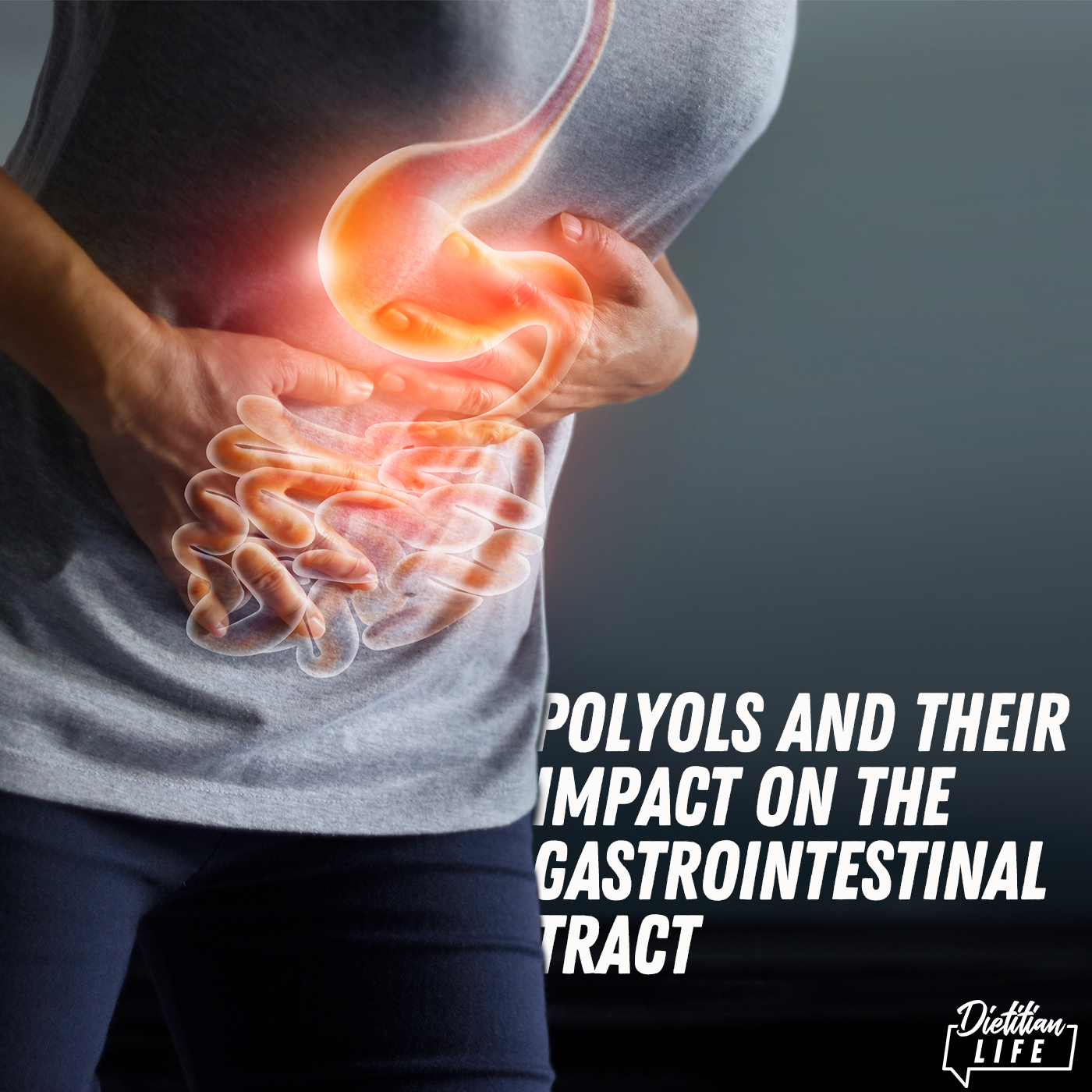Polyols refer to a group of sugar alcohols that make up the ‘P’ in FODMAP, Fermentable Oligo-saccharides, Di-saccharides, Mono-saccharides and Polyols. Polyols can be found in certain fruit and vegetables, in addition to more commercial products including sugar-free beverages, lollies and chewing gum. Diets that are low in these short-chain, poorly absorbed carbohydrates hold merit for improving gastric symptoms, however, what is the specific role of polyols in this picture, and how can we as dietitians apply this information to improve our client’s symptoms?
Absorption and Malabsorption of Polyols
Around one-third of the polyols consumed through the diet are absorbed in the small intestines. The absorption capacity is variable and influenced by:
- The molecular size of each type of polyol,
- The amount of polyol consumed and,
- The client’s gastrointestinal system and epithelial pore size.
For polyols including sorbitol, isomalt, lactitol and maltitol, malabsorption appears to occur in a dose-dependent manner, regardless of if the client is healthy or suffers from Irritable Bowel Syndrome (IBS).
When comparing the lowest and highest molecular weighted polyols, erythritol and sorbitol respectively, the results indicate the erythritol is well absorbed, accounting for 90% in the small intestines, whereas sorbitol is poorly absorbed. A study by Corazza and colleagues found that after the consumption of 10g and 20g sorbitol solutions, 90% and 100% of healthy participants respectively had malabsorption.
Dose matters when it comes to this sugar, with the effect amplified when consumed with other polyols or in large quantities. Furthermore, the effects of malabsorption have been reported in numerous studies to worsen when multiple polyols are consumed together. This has been hypothesised to arise from competing for the same intestinal transporters. As dietitians, we can help formulate meal ideas with clients to lower their consumption of polyols, whilst also preventing combinations of polyols from appearing within the same meal.
Polyol Inducing Symptoms
Symptoms arise from the malabsorption of polyols and their onset is dependent on the dose consumed. This has been observed through studies that compared various polyol solutions ranging from 5g to 25g, with worsening and more severe symptoms reported as the dose increased. It was also found that clients with IBS often reported symptoms after lower doses, likely due to their hypersensitivity. As such we should consider more stringent restrictions on polyol intake for these clients where warranted.
Common symptoms of polyol malabsorption for us as dietitians to be vigilant of include:
- Flatulence
- Abdominal discomfort
- Laxative effects
Sorbitol is known for exerting greater osmotic load, leading to an increase in pressure in the colon from water retention, resulting in a greater laxative effect. As such if clients are specifically having problems with diarrhoea episodes, sorbitol would be a suitable initial consideration.
As dietitians, we can play an important role in identifying key offenders to gastric distress for our clients to improve their health, nutritional status and quality of life.
Polyols are mal-absorbed carbohydrates, aka sugar alcohols. These can be found in certain fruits and vegetables and as an artificial sweetener. Polyols have a laxative effect on the body and are often associated with negative symptoms such as diarrhoea and cramping, but they also have the potential to be useful in treating constipation in adults and children when used appropriately.
Therapeutic Use
Polyols can be used in practice to assist with simple constipation and in the appropriate dose can be an easy strategy to implement.
The effect is dependent on the dose consumed, so when using these to help clients, it is best to start with small amounts and build incrementally.
Fruits are the best and most readily available form of polyols and exist in the following consumable forms. Fruit and juice are the best options for clients and have the following effect at the dose prescribed.
- Dried Fruit
- Prunes 3-4 daily
- Pears – 4 halves daily
- Dried Mango – 3 cheeks daily
- Juice – 300ml daily
- Pear/Prune
These doses will have a gradual effect on constipation, not rapid and as such will only soften the stools and promote bowel actions.
If you have overloaded the client, then clients may suffer from malabsorption and have the following symptoms;
- Increased gas production and smell
- Increase in abdominal discomfort
- Uncontrollable urgency
These are options, and some clients may need more time or larger doses to have the desired response. We can certainly use food in this way to achieve a gradual effect on constipation but should always consider the most appropriate treatment option.
As dietitians, we can play an important role in identifying key offenders to gastric distress for our clients to improve their health, nutritional status and quality of life.
Want to learn more? Sign up for a FREE Dietitian Life membership to get exclusive access to the huge library of clinical advice, and practical dietetic resources.

